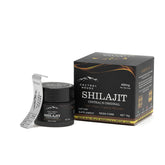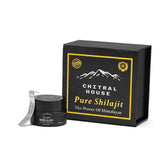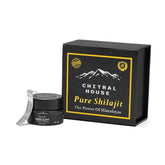Shilajit, often called the “Conqueror of Mountains” or the “Gold of the Himalayas,” has been a cornerstone of traditional Ayurvedic medicine for thousands of years. It’s a complex, sticky, tar-like mineral substance that oozes out of rocks in high mountain ranges, primarily the Karakoram, Himalayan, and Altai mountains.
For those in Pakistan, this natural wonder is particularly accessible, often sourced directly from the rugged terrains of Gilgit-Baltistan.
However, high demand—combined with the difficulty and expense of harvesting true, pure Shilajit—has led to a major problem: the market is flooded with fakes.
Buying Shilajit in Pakistan, whether online or from a local vendor, requires caution, knowledge, and a few simple tests. If you’re investing your money and, more importantly, your health into this potent substance, you need to be absolutely certain you’re consuming the real deal and not a harmful, cheap substitute like asphalt or processed mineral pitch.
This detailed buyer’s guide will arm you with everything you need to know—from vetting your supplier to performing simple, essential tests in your own kitchen.
The Authenticity Crisis—Why Fakes Are Rampant
Shilajit is a genuine natural mineral found in the mountains, but its value and scarcity make it a prime target for counterfeiters.
The Difficulty of Sourcing
Original Shilajit is only available during the warmest summer months when the heat causes the dense mineral layer to soften and exude from rock crevices. This harvesting process is challenging, dangerous, and low-yield.
The sheer effort required to collect, purify, and transport this substance from remote locations contributes heavily to its final, high price.
The Temptation to Cut Corners
Because genuine Shilajit is expensive to produce, many unscrupulous vendors try to create cheaper, more readily available substitutes.
These fakes are often made from industrial resins, low-grade mineral extracts, or even processed mud and tar. They might look similar, but they lack the critical ingredient: a high concentration of fulvic acid.
Fulvic acid is the key organic compound in Shilajit that enables your body to absorb minerals and nutrients efficiently. Without it, the product is useless—or worse, potentially toxic due to heavy-metal contamination.
Understanding Genuine Shilajit (The Baseline)
What Is True Shilajit?
Genuine Shilajit is the result of thousands of years of decomposition of plant matter and microbial life, compressed by layers of rock—a dense, nutrient-rich biomass.
When sold as a resin, it should appear as a dark, glossy, reddish-brown to black tar.
The Key Ingredient: Fulvic Acid
The gold standard for any Shilajit purity test—especially in a lab—is its fulvic-acid content. A high-quality resin should have at least 50% fulvic acid.
Fulvic acid acts as a powerful electrolyte and aids cellular energy and detoxification. Fakes contain little to none.
Forms of Shilajit to Look For
- Resin: A thick, sticky paste that is purified and condensed. This is the best form, as it retains the most natural properties.
- Powder: Dried and pulverized resin. While convenient, powders are easier to cut with fillers (e.g., cheap flours or mineral powders), making them riskier.
Always prefer the resin form when verifying authenticity; counterfeiters struggle to mimic its unique texture and behavior.
The Buyer’s Guide—Vetting Your Supplier
1) Demand Sourcing Transparency
A legitimate seller—especially in Pakistan—should specify where their product is sourced. Look for vendors who cite Gilgit-Baltistan or specific ranges like the Karakoram or Hindu Kush.
Vague claims like “Himalayan Shilajit” without a country or region are a red flag.
2) Check for Third-Party Lab Testing
This is non-negotiable. Serious vendors provide a recent Certificate of Analysis (COA) from an independent lab.
If a vendor only offers an in-house report, be skeptical—you need unbiased verification.
3) Safety First: Heavy-Metal Reports
Shilajit can contain traces of heavy metals (lead, arsenic, mercury, cadmium). These must be within strict safety limits.
The COA should show compliance with international safety standards (often aligned to FDA/WHO criteria). If a vendor cannot provide heavy-metal testing, walk away.
4) Investigate Fulvic-Acid Content
Look for a COA that states the percentage. Under 50% suggests low-quality raw material or insufficient purification. Premium products often report 60–75%.
The At-Home Identification Tests (The Kitchen Lab)
With resin in hand, use these simple tests to spot the real deal.
Test 1: The Solubility Test (The Dissolving Rule)
How to perform:
- Take a pea-sized piece of resin.
- Drop it into a glass of lukewarm water.
- Do not stir immediately.
Original Shilajit: Dissolves completely within minutes, turning the water dark reddish-brown/amber; the liquid stays clear with no grit, clumps, or film—and it dissolves even without stirring.
Fake Shilajit: Clumps, leaves residue, gritty sediment, or turns water milky; asphalt/bitumen often remains stubbornly solid.
Test 2: The Heat and Pliability Test (The Finger Test)
How to perform:
- Hold a small piece between thumb and forefinger for 10–15 seconds.
- Optionally, touch with a hot needle or lighter.
Original (Finger): Becomes very soft, sticky, and pliable—like warm gum.
Original (Heat): Bubbles and chars but does not catch fire or emit persistent black smoke.
Fakes: Asphalt/tar remains hard and ignites with black smoke; waxes/gums melt into a puddle and smell plasticky.
Test 3: The Cold Test (The Brittle Rule)
How to perform: Freeze a small piece for 30 minutes, then try to snap it.
Original: Turns rock-hard and brittle; snaps/shatters.
Fakes: Stay rubbery; dent or bend instead of snapping.
Test 4: The Alcohol Test (The No-Go Zone)
How to perform: Drop a small piece into isopropyl alcohol or strong ethanol.
Original: Does not dissolve (may soften slightly).
Fakes: Asphalt/petrochemical mixes often dissolve partially or fully—major red flag.
Test 5: The Smell and Taste Test
Original: Distinct earthy, slightly smoky aroma (humus/resinous), strong bitter and mildly astringent taste with a warm, resinous afterfeel; never petroleum-like.
Fakes: Overly chemical/burnt smell or oddly pleasant/sweet taste suggests adulteration.
Final Safety Check—A Note on Heavy Metals
Your biggest risk from fake Shilajit isn’t just lack of benefits—it’s heavy-metal exposure. Purification should remove the vast majority of toxic elements, leaving only safe traces.
The Danger of Unpurified Shilajit
Unethical sellers may skip purification to cut costs, leaving dangerously high levels of lead, arsenic, and cadmium—metals that accumulate and damage the nervous system, kidneys, and brain.
The Mandatory Verification
Request third-party results confirming at least the following limits:
- Lead (Pb): < 0.5 ppm
- Arsenic (As): < 0.5 ppm
- Mercury (Hg): < 0.1 ppm
If a vendor claims trusted Pakistani sourcing, they should prove their purification meets global safety standards.
Conclusion—The Smart Buyer’s Checklist
Shilajit can deliver real benefits for energy, vitality, and overall health—but only if it’s authentic and purified. Don’t be swayed by low prices; if it seems too good to be true, it probably is.
Final checklist for identifying original Shilajit:
- Vendor vetting: Current third-party COA showing low heavy metals and > 50% fulvic acid.
- Solubility: Dissolves completely/cleanly in warm water without stirring; no grit or clumps.
- Pliability: Becomes sticky and soft in your hand.
- Heat reaction: Bubbles/ chars without catching fire (fire/black smoke = asphalt).
- Location: Clear sourcing from high-altitude Pakistani ranges such as Gilgit-Baltistan.
Apply these tests and demand transparency to confidently invest in genuine Shilajit—and enjoy the benefits this true “Mountain Gold” is known for.








